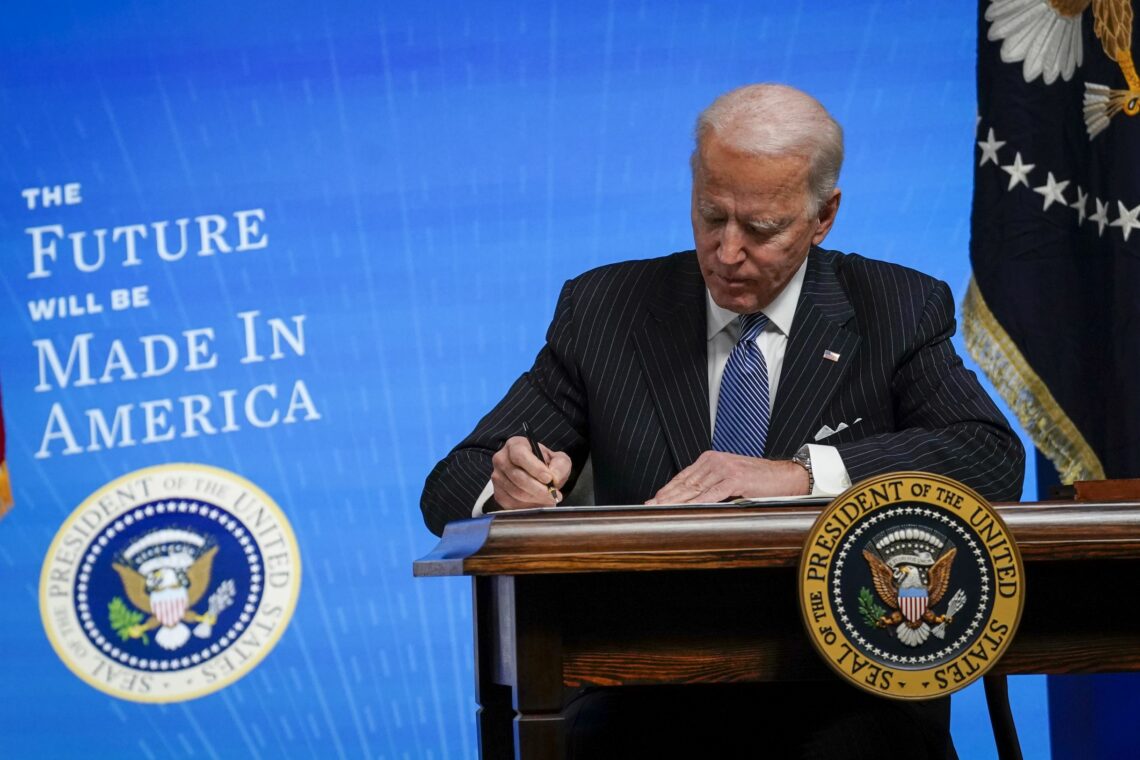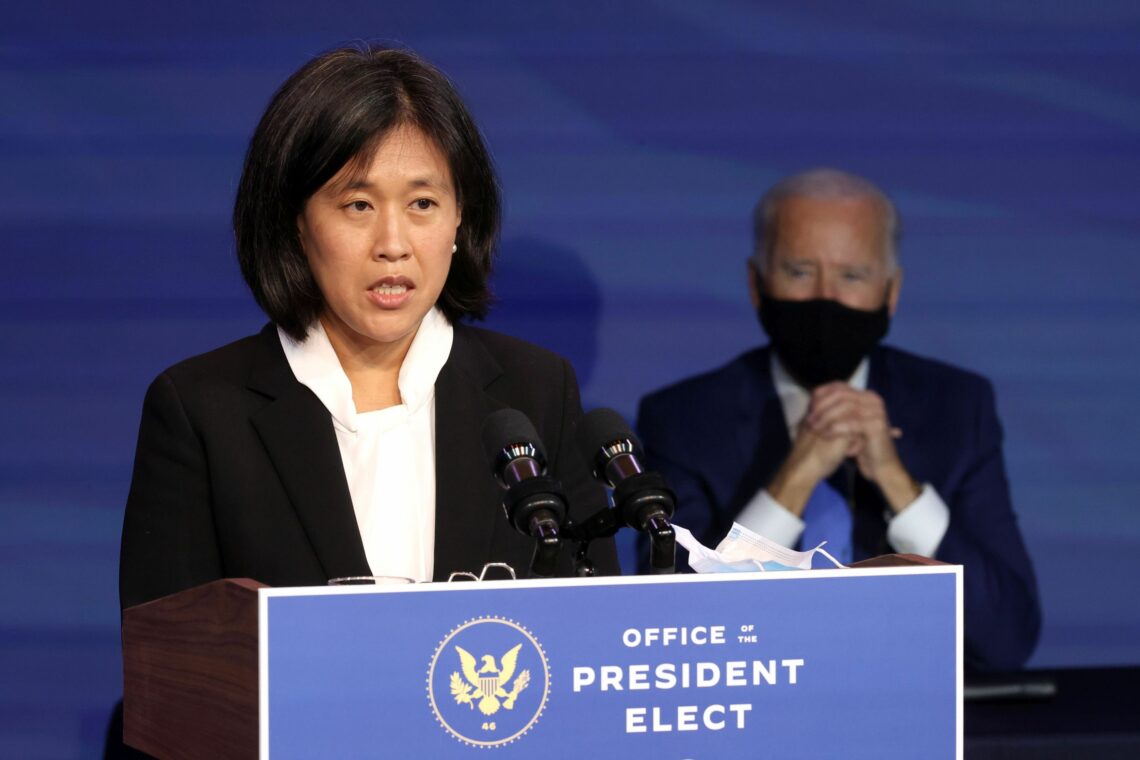Scenarios for U.S. trade policy under Biden
When it comes to trade policy, the Biden administration’s biggest departure from its predecessor’s stance will be an emphasis on climate change. Tariffs are likely to remain in place, however – and Congress shows little enthusiasm for trade agreements.

In a nutshell
- President Biden will continue to promote domestic production
- He is unlikely to lift tariffs or end the dispute with China
- The new administration is unlikely to conclude new trade deals
With a new president in the United States come new priorities for the country’s trade policy. The administration of former President Donald Trump prioritized promoting free, fair and reciprocal trade even if it meant targeting America’s largest trading partners – allies and competitors alike – with punitive tariffs.
It also emphasized domestic manufacturing and employment. This included using out-of-date national security laws and renegotiating some of America’s existing trade agreements to benefit U.S. production.
On this issue, the Trump administration will likely most be remembered for the “trade war” between Washington and Beijing. The dispute is set to continue during the administration of President Joe Biden, with tariffs remaining on hundreds of billions worth of traded goods.
Trade policy under the Biden administration will probably shift the country’s priorities toward environmental and social issues, while continuing to support labor interests. This could mean targeting certain products, especially from partners that have substandard environmental records.
There is likely to be a lot of continuity between the Trump and Biden trade policies.
Relations with China will remain a touchy issue, but it is an open question whether the Biden White House will take as combative a stance against Beijing as the Trump administration did. President Biden has expressed an interest in working more with U.S. trading partners, in contrast to President Trump’s more aggressive negotiating tactics. However, there will likely still be a lot of continuity between the Trump and Biden trade policies.
While there are a few issues the Trump and Biden administrations agree upon, like promoting domestic production, the Biden White House has several priorities that are markedly different than its predecessor’s.
Climate change
President Biden considers climate change an existential threat to the U.S. and the world. It will probably be the Biden White House’s top priority for trade and international relations, and a bigger concern than issues involving China. President Biden may even go as far as to declare climate change a threat to U.S. national security under his authority through the International Emergency Economic Powers Act.
It is difficult to predict the lengths to which the Biden administration will use U.S. trade policy to address climate change. However, policymakers in Washington have learned from the events of the Trump era that they have a lot of room for maneuver. A broad interpretation of Section 301 of the Trade Act of 1974 can target other countries’ unfair economic practices, while Section 232 of the Trade Expansion Act of 1962 can be used to address national security concerns.

One idea that has gained some traction is a possible carbon tax on imports, which is basically a border adjustment tax for imports from countries that have substandard environmental regulations. However, unlike the Section 301 and Section 232 authorities which are held by the executive, a broad carbon tax may require new legislation.
If Congress is unable to deliver such legislation, the Biden administration may act unilaterally and use its powers under Section 232. His predecessor had taken that step to impose tariffs on steel and aluminum imports and threatened to slap similar tariffs on imports of automobiles and car parts. However, the Trump White House also came close to losing much of this authority after Congress discussed reforming Section 232 due to Mr. Trump’s irregular use of the law. Legislators may consider curbing this authority again if the Biden administration abuses it to address climate change.
Labor interests
Democratic administrations have long favored pro-labor policies. President Biden’s will be no exception. The president himself recently said that he is a “union guy.” Many of the administration’s agency review teams, like that for the Office of the U.S. Trade Representative (USTR), included members of the American Federation of Labor and Congress of Industrial Organizations, the largest federation of unions in the country. Katherine Tai, Biden’s nomination for USTR, plans to pursue trade policies that prioritize workers.
It is fair to assume labor (particularly union) interests will figure prominently in future trade policy and negotiations. There will be a push for minimum wage standards in trade negotiations – like the minimum wage for automobile manufacturing that was established in the U.S.-Mexico-Canada (USMCA) trade agreement. Labor interests will also likely include more stringent labor standards and an emphasis on sourcing domestically or buying American.
Currency manipulations
Foreign exchange under President Biden may be one area of trade policy that is not getting enough attention. Democrats have long criticized other countries’ (particularly China’s) attempts to keep their currencies weak relative to the U.S. dollar. Brad Setser, who was on Mr. Biden’s agency review team for USTR has argued that Taiwan’s currency is being undervalued – making it a potential target for the new administration.
Democrats have criticized other countries’ attempts to keep their currencies weak.
The difficulty is that we cannot be sure how far the Biden administration will go to address currency issues yet. Generally, such matters are handled through the Treasury Department. The Trump administration, however, used its Section 301 authority, through the USTR, to investigate Vietnam’s currency practices. The investigation could lead to tariffs on $3.6 billion worth of imports from Vietnam. It will be up to President Biden’s USTR to determine what action to take, whether to impose tariffs and continue this new precedent in which the USTR takes a bigger role in U.S. currency policy.
No new trade deals
A big question is whether the Biden administration will pursue new trade agreements. Under President Trump, the U.S. began several trade negotiations that the Biden team will have to finish or abandon, including with the U.K., Japan and Kenya. It is unlikely, however, that it will enter into any new negotiations
Given the recent signing of the Regional Comprehensive Economic Partnership – a huge trade agreement between 15 countries in the Asia-Pacific region – there is some pressure on the Biden administration to join the Comprehensive and Progressive Agreement for Trans-Pacific Partnership (CPTPP), which went into force a little over two years ago. But Congress’ interest in joining CPTPP remains lukewarm at best.
Another important issue is that the Trade Promotion Authority (TPA) expires this year. The TPA helps expedite trade agreements through Congress without too much public debate. However, there are concerns that the TPA may not be reauthorized, making it unlikely any new trade agreements will be introduced.
President Biden may resort to sectoral agreements through executive actions.
Getting a new, comprehensive trade agreement through Congress can take time. With TPA expiring and potentially no new trade deals being signed, the Biden administration may instead resort to sectoral agreements through executive actions – like the U.S.-Japan Digital Agreement – for various issues. It would not be surprising to see the president pursue bilateral or multilateral agreements with various countries aimed at addressing climate change or encouraging more women in the workforce. While these types of agreements are more limited than a comprehensive trade deal, they could be negotiated through the White House instead of waiting for Congress to act.
Scenarios
It is highly likely that climate change will become a bigger part of U.S. trade policy, possibly through various sectoral agreements. It could also use the leverage created by the trade war with Beijing to negotiate a U.S.-China climate agreement. Now that the U.S. has tariffs of more than 25 percent on hundreds of billions worth of imports coming from China, the Biden team may be willing to negotiate these away in exchange for significant climate commitments from Beijing.
We should also expect to see more “buy-and-hire American” executive orders and proposals come out of the White House. For example, pharmaceutical and personal protective equipment imports have increasingly come under scrutiny. The Biden administration could try and relocate some of that sourcing and manufacturing back to the U.S.
It is only somewhat likely that currency issues will become an issue for the Biden White House. These often complex matters can drive a wedge between the Treasury Department and the USTR. It is also only somewhat probable that the tariffs that have been implemented during the Trump administration (on steel and aluminum, washing machines, and on imports from China, among others) will be completely removed in the early days of the Biden administration, if at all.
Finally, it is unlikely that trade policy during the Biden administration will bring in any new deals. That is the case not only because the president is more focused on domestic economic policy than on trade policy, but also because Congress has lost its appetite for such agreements. There are very few in Congress who still find value in pursuing free trade.








